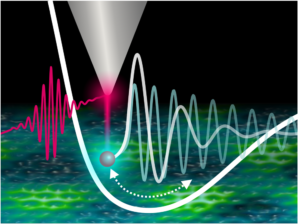
The functionality of a material and its macroscopic response to external stimuli are dictated by the microscopic interactions of its elementary degrees of freedom – electrons, lattice, and spin. Understanding the fundamental mechanisms and complex many-body interactions that determine relevant material properties is a main goal of modern solid state research. In spatially inhomogeneous crystals, atomic-scale variations of the crystal lattice and/or its electronic structure will alter the microscopic response – may it be due to imperfection in the presence of defects, or by design due to the growth of nanoscale heterostructures. Whereas femtosecond pump-probe techniques provide insight into microscopic couplings by following the non-equilibrium response and dynamics of a system in real-time, very few experimental approaches exist to date which are capable to resolve such dynamics locally on the relevant length scales down to a single atom.
Coherent phonon spectroscopy is a powerful tool to monitor ultrafast lattice dynamics under nonequilibrium conditions. Such collective, in-phase vibrations of a crystal lattice can be excited by ultrafast laser pulses and can be used, for example, to monitor a light-induced phase transition in strongly correlated materials in real time and even to control its outcome. Despite the important role of the local crystal structure for such dynamics, it has not been possible so far to measure coherent lattice vibrations with high, few nanometer, spatial resolution. In this work we demonstrate nanoscale coherent phonon spectroscopy by means of ultrafast laser-induced scanning tunneling microscopy (STM) in a plasmonic junction. Comparison of the CP spectra with tip-enhanced Raman spectroscopy allows us to identify the involved phonon modes. In the all-optical pump-probe STM approach, the laser-excited coherent phonons periodically modulate the photoinduced tunneling current generated by the probe pulse, for which it is crucially that the laser excitation is resonant with an optical transition in the electronic structure of the hybridized ZnO/Ag(111) system. Moreover, in contrast to the Raman spectra, the relative CP intensities exhibit strong nanoscale spatial variations, which correlate with changes in the local density of states recorded via scanning tunneling spectroscopy. A new aspect of this work is that the photoinduced tunneling current is not modulated by a periodic change of the tip-sample distance, but likely by coupling of the phonons to the local electronic structure, which in turn leads to a modulation of the resonantly excited photocurrent. Our work introduces a new approach to probe the ultrafast structural response of a photoexcited solid using STM, and opens up new possibilities to study and control of ultrafast dynamics at solid surfaces and in low-dimensional quantum materials.
Original publication: S. Liu, A. Hammud, I. Hamada, M. Wolf, M. Müller, T. Kumagai, Nanoscale coherent phonon spectroscopy, Science Advances.
Science Advances 8, eabq5682 (2022) • DOI: 10.1126/sciadv.abq5682